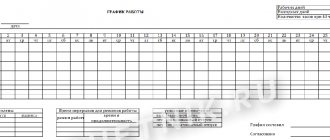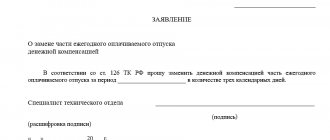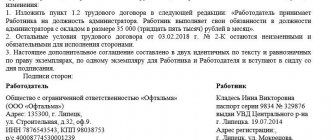The time sheet is intended for entering information about the time actually worked by employees of organizations. It must be said that the time sheet form is not strictly mandatory - in principle, it can be arbitrary, that is, each enterprise is free to use its own time sheet form if such a need arises. However, the form was developed and recommended for use by the State Statistics Committee of the Russian Federation and is preferable.
- Form and sample
- Free download
- Online viewing
- Expert tested
FILES
Who fills out the time sheet?
The form is filled out either by an employee of the HR department, or by the head of a structural unit, or by a timekeeper specially hired for this function. Based on the information entered into it, the accounting department specialists calculate wages and other payments to the organization’s employees. In fact, the time sheet is one of the most important accounting documents. And while small companies can easily do without it, large enterprises are required to keep such timesheets.
Depending on the personnel records system adopted at the enterprise, a time sheet can be generated either one for all employees of the organization, or maintained separately in each department.
The timesheet is a regular document, that is, a new copy must be compiled every month, so the serial number of the timesheet will be equal to the serial number of the month in which it was created. The timesheet preparation period covers all days of the month.
You can fill out the timesheet either electronically or in writing. However, after entering all the necessary information, it will still have to be printed for the signatures of the responsible persons.
Reflection of days of temporary disability in the timesheet: step-by-step instructions
When an employee is notified that he has been issued sick leave, the HR officer must follow these steps:
| Steps | Description |
| 1 | Select the appropriate one from the symbols (codes) |
| 2 | Write the code in the top line (numerator) of the timesheet opposite the employee’s last name. It is entered on those days of the month that are noted on the sick leave |
| 3 | After two weeks and at the end of the current month, determine how many days and hours worked. Fill in lines 5, 7-13. |
| 4 | Calculate the number of days and hours of sick leave and write the result on pages 14 and 16. On page 15, enter the code again |
| 5 | Sign the timesheet, approve it with the manager and submit it to the accounting department for payroll. The copy should be placed in a separate folder |
When an employee submits a closed certificate of temporary incapacity for work, it is necessary to check its execution: whether all the necessary fields are filled in, whether the seal and signature are in place.
Important! The report card is kept by a specialist who is assigned the corresponding responsibility by order of the manager. This could be a personnel officer, an accountant. It is possible that the director retains such accounting for himself.
Form T-13. Shape Features
Let's start with the T-13 form, which is now used much more often for maintaining time sheets.
The unified form T-13 or electronic time sheet is well known to HR department employees. This is not the only way, but it is definitely the most standard way to account for hours worked. If you keep records manually, you should use Form T-12.
Timesheets are a common tool for tracking employee attendance. Form T-13 allows you to record in detail the reasons for absence from work, including student leave during the session, advanced training and several types of disability leave. The period for which the document is completed may be less than 31 days.
A completed T-13 is the basis for calculating wages.
How to keep a timesheet
By law, the employer has the right to choose one of the following methods:
- continuous - registration of appearances, absences and any deviations from the normal work schedule, such as work on holidays, overtime, business trips;
- by deviations - registration only of absences, overtime and other deviations from the standard work regime.
In practice, everyone uses the continuous method, and accounting for deviations is almost never used. This is due to the fact that personnel records are almost completely automated, and electronic processing of forms T-12 and T-13 does not allow leaving empty cells. However, when recording working hours in aggregate, when the number of hours worked in different shifts may differ from the norm, a continuous method should be used. This will allow you to see possible overtime after the end of the accounting period and adjust the further involvement of the employee in work.
Format for filling out a working time sheet in T-13
Unlike arbitrary tables of similar content, T-13 contains data about the enterprise, including the form of ownership and OKPO. The document number is entered in accordance with internal requirements for maintaining timesheets.
The department name is also shown at the top. It must be remembered that the head of this department (even if filling out the time sheet is not his or her responsibility) must sign the completed form.
The order of employees is determined by the decision of the person in charge. Most often, alphabetical sorting is found, as in our example, but the option of arranging by personnel number is possible (column 3).
In column 4 we put marks by day:
I - (appearance) working day, B - day off, FROM - vacation, RP - attendance on a day off (working out), K - business trip, PC - advanced training, U - study leave with a call from an educational institution, B - sick leave with sick leave sheet, T - unpaid sick leave without sick leave.
Under the I mark we put the number of hours worked that day. In column 5 we summarize the number of I in the line and the number of hours. We get 4 values for 2 halves of the month. In column 6 we sum up the values and get the final figure for the work for the month.
The number of hours for B, OT, K, B and other cases is not indicated in the fourth column. For this there are columns 10-13.
Accounting for sick leave, vacations or absences for other reasons
Designation codes may be different (for example, numeric). There is no specific format required by law.
The notation X shows that we are not taking this day into account: for convenience, the month is divided into two lines with unequal values. For months with 30 days (for example, November, the column will look like this (for convenience, the “non-existent” 31st number is highlighted in red):
T-13 for November
By analogy, T-13 is filled out for visits in February.
Columns 7-9 indicate the payment code, number of days and type of charges. Our example uses the following codes:
- 2000 - Common workday,
- 2300 – sick leave (disability benefit),
- 2012 - vacation.
Alternative solution
Some enterprises approve a slightly simplified version of the time sheet without detailing the reasons for omissions. Column 4 indicates only 2 codes:
- I am a working day
- N - unworked day.
This method may be inconvenient because it does not record sick leave.
Special cases
- How to fill out T-13 for employees participating in conferences and other training events?
- Can code I have a value of more than 8 hours?
- What is the difference between report cards T-12 and T-13?
Depends on the position of the enterprise. These days can be counted as working days (I), or as advanced training (PC). Pay rates may also vary.
Yes. Maybe if there is a special order about extended working hours. Overtime hours can be marked with the symbol C.
The first is a manual attendance form. The second is electronic. Many accounting departments today have switched to T-13, since it can be automatically collected using a special program.
How are sick days reflected?
To indicate days of incapacity
There are two codes.
Their application depends on whether benefits are due during this time. If it is paid, it is marked with o or “19”. When compensation is not due, code “T” or “20” is displayed. Situations where benefits are not paid are established by Art.
9 of Law No. 255-FZ of December 29, 2006 :
- for the period of release
of the employee from work with full or partial retention of wages or without payment in accordance with the legislation of the Russian Federation, with the exception of cases of loss of ability by the employee due to illness or injury during the period of annual paid leave;- for the period of suspension
from work in accordance with the legislation of the Russian Federation, if wages are not accrued for this period;- during the period of detention
or administrative arrest;- during the period of the forensic medical examination
;- during the period of downtime
, except for the cases provided for
in Part 7 of Article 7 of this Federal Law
.- the onset of temporary disability as a result of a court-established intentional infliction of harm to one's health by the insured person or an attempted suicide
;- the onset of temporary disability as a result of the commission of an intentional crime
.
The organization itself chooses which designations (letter or numeric) it will use. The code is placed opposite the employee’s last name in the top line - on those days of the month on which the person was sick (recorded on the sick leave). At the end of each half of the month, the number of working days is summed up in the timesheet. When closing a period, deviations in days and hours are recorded.
The timesheet can be filled out in two ways:
- Continuous - daily about the employee.
- By deviations - only notes about deviations from the regular schedule are entered (vacations, downtime, sick leave, business trips, etc.).
The man got sick
and did not go to work, but did not warn about it. In such situations, “NN” or “30” are entered on the report card. This reflects absence for unknown reasons. Subsequently, when a person brings a certificate of incapacity for work, the codes change to “B” (19) or “T” (20).
An employee took sick leave during annual leave
- vacation is extended by the number of sick days that fell on it. In some cases, by agreement of the parties, the vacation is postponed to another time. In the time sheet, the vacation code “FROM” (09) is replaced with the corresponding sick leave code. Thus, the issue of extending vacation is resolved if the employee has previously warned about the coincidence or provided sick leave.
When an employee independently extended his vacation
, without warning about it, days of absence about (30). Corrections are made after submitting a certificate of incapacity for work.
Important
! Annual leave is not extended if sick leave was issued to care for a child or other relative.
An employee can go to the clinic on a weekend (holiday). If the patient’s health does not allow him to go to work after the weekend, sick leave is opened on the same day.
Part 8 of Article 6 of Law 255-FZ
says the following:
“Temporary disability benefits are paid to the insured person in all cases specified in parts 1 - 7 of this article
, for calendar days falling within the corresponding period, with the exception of calendar days falling within the periods specified in
Part 1 of Article 9 of this Federal Law
."
This means that all sick days, including weekends, are reflected in the sick report card.
What if an employee worked his shift and went to the doctor in the evening? In this case, code “B” is entered from the next day so that there is no overlap of one event with another.
For an internal part-time worker, the time sheet is kept separately for each position he occupies. Sick leave is recorded on all lines.
Let's look at a sample report card
accounting of working time with sick leave using an example.
The employee fell ill on his day off and was absent from work for 10 days. He notified the HR department about his illness, and on September 19 (the first working day after his illness) he brought in a certificate of incapacity for work.
For all 10 days, Fr. is placed on the report card. In column 10 of the form, “B” is also entered. In column 11 the number of days (hours) of illness, in our case – 10 (80).
Form T-12
First of all, as in any other personnel records document, you first need to enter the details of the organization into the timesheet: its full name indicating the OKPO code (must be taken from the registration documents), organizational and legal status (IP, LLC, CJSC, JSC), as well as the structural unit (department) for which this timesheet is maintained (if necessary).
Then you need to enter the document number for internal document flow in the appropriate column, and also indicate the reporting period that this timesheet takes into account.
Example 2. Reflecting absence using the document “Absence (illness, absenteeism, no-show)”
Let's leave the initial data of Example 1 and solve the problem using the document Absence (illness, absenteeism, failure to appear) .
Let's create a new Accrual (Settings - Accruals) by copying a standard accrual for sickness absence (sick leave has not yet been closed) . On the Time Tracking , change the value of the Type of time to Unpaid sick leave .
Then we will create a new document Absence (illness, absenteeism, no-show) . We will indicate the reason for absence : Illness (sick leave is not yet closed) and the type of time : Unpaid sick leave . After setting these settings, the accrual of sickness absence (sick leave has not yet been closed) will automatically be reflected in the document.
In the Report Card, days from 20 to 24 will be indicated by the code “ T ”:
Did the article help?
Get another secret bonus and full access to the BukhExpert8 help system for 14 days free of charge
Numerical and alphabetic codes in the time sheet
This part of the timesheet includes the alphabetic and numeric codes used to fill out the necessary information for employees, as well as their decoding. They must be entered in the main part of the timesheet in order to briefly and clearly reflect the amount of time actually spent by one or another employee at the workplace, as well as the reasons for his absence from work. If HR department specialists need to enter some additional codes into this timesheet form, they can be developed independently and entered into this table.
What to do in special cases
External part-time worker
In the timesheet, show the time that the part-time worker actually worked, but do not forget about the restrictions of labor legislation.
An employee cannot work more than 4 hours part-time if he worked at his main place all day. A part-time worker works more than four hours only on those days when he is not busy at his main place of work.
It is not forbidden to indicate fractional numbers. For example, if a part-time worker works daily for 4 hours 15 minutes, then enter a fractional number on the timesheet - 4.25 hours (4 hours + 15 minutes: 60 min/hour).
Internal co-worker is sick
Enter code “B” or “19” in the report card. Indicate the same codes in the line where his working time for his main position is taken into account. When paying sick leave, the employee’s total earnings are taken into account - both main and part-time.
The employee worked a full day, and in the evening he was sent on sick leave
In fact, the employee worked the entire day and it doesn’t matter that he was issued sick leave that same evening. Therefore, put the code “I” or “01” with full working hours on your timesheet.
Day off on a business trip
For business trips, use the code “K” or “06”. For weekends - code “B” or “26”. Therefore, if an employee has a day off on a business trip, use a double code: “K/V” or “06/26”. It will show that this is a business trip and the employee needs to accrue daily allowance, and code “B” - that there is no need to save the average earnings for this day off.
If an employee works on his day off on a business trip, use the code “K/RV” or “06/03”. After all, he is entitled not only to daily allowance, but also to increased payment or time off. “RV” or “03” are codes for working on weekends and non-working holidays.
Working time recording in T-12
This section in the timesheet is the main one - it is where working time is kept track of. First, you need to enter the employee’s serial number in the first column of this section, then in the second - his full name (preferably his full name and patronymic to avoid confusion and errors). In the third column you need to insert the employee’s personnel number assigned to him during employment (it is individual and never repeated).
For each employee, the timesheet has two lines - they contain encrypted information about presence or absence at the workplace on each calendar day of the month. In addition, it is necessary to immediately indicate the reason for absence from work, if one has been established.
The reason is indicated in the top line opposite the employee’s full name, and in the bottom line the number of hours actually worked, and if the employee did not appear at the workplace, the bottom cell can be left empty.
The next step is to calculate the total number of hours and days actually worked for two-week periods, and at the end of the table - the result of the calculations for the month.
In this case, you should carefully monitor that the total number of calendar days in a month coincides with the amount of working days, weekends and holidays indicated for each employee.
It should be said that sometimes those responsible for filling out the time sheet only enter information that relates to the days when the employee was absent from the workplace. However, this option may lead to personnel and accounting errors, so it is not advisable to use it.
What is the maximum period of sick leave reflected in the report card?
The maximum period of sick leave reflected in the report card coincides with the deadlines for which a certificate of incapacity for work is issued.
Typically, a certificate of incapacity for work is issued for a period of up to 15 days. Further extension is possible by decision of the medical commission.
An employee has the right to be on sick leave for up to 10 months during the year. If a serious operation is performed or a major injury is received, a certificate of incapacity for work is issued for 12 months.
Most often, after 4 months of continuous illness, the question of a citizen’s disability is raised. After passing a medical and social examination and establishing the disability group, the sick leave is closed. The employer reflects the actual days of sick leave after the certificate of incapacity for work is closed.
Several methods for filling out timesheets
Office management provides for the following methods of maintaining timesheets:
- Complete registration.
- Registration of deviations.
The first method involves filling out each cell of the report card. The employee’s “condition” is recorded daily: working the whole day, going on vacation, being on sick leave, etc.
When using the second method, only deviations from the standard work schedule are recorded in the timesheet. Sick leave, part-time work, vacations, and absences for unknown reasons are recorded. They are reflected in the top line with symbols. The bottom column of the line is not filled in.
If there are no deviations from the standard schedule, the cells are left empty. This means that the employee worked as usual for the entire month.
Important! It is necessary to fill out the time sheet carefully, since errors or inaccuracies can cost the company a fine.
State Labor and tax specialists are often interested in this primary document. Inaccuracies in filling out lead to incorrect calculation of salaries, social contributions and taxes. Such errors entail administrative liability.
The amount of the fine for officials and entrepreneurs working without forming a legal entity ranges from one to five thousand rubles, for enterprises - 30-50 thousand rubles.
| ★ Collection and directory of all personnel documents (forms and documents in word format) > 1200 books purchased |
To organize personnel records in a company, beginner HR officers and accountants are perfectly suited to the author’s course by Olga Likina (accountant M.Video management) ⇓
| ★ Author's course “Automation of personnel records using 1C Enterprise 8” (more than 30 step-by-step video lessons for beginners with instructions) purchased > 2000 practical courses |








